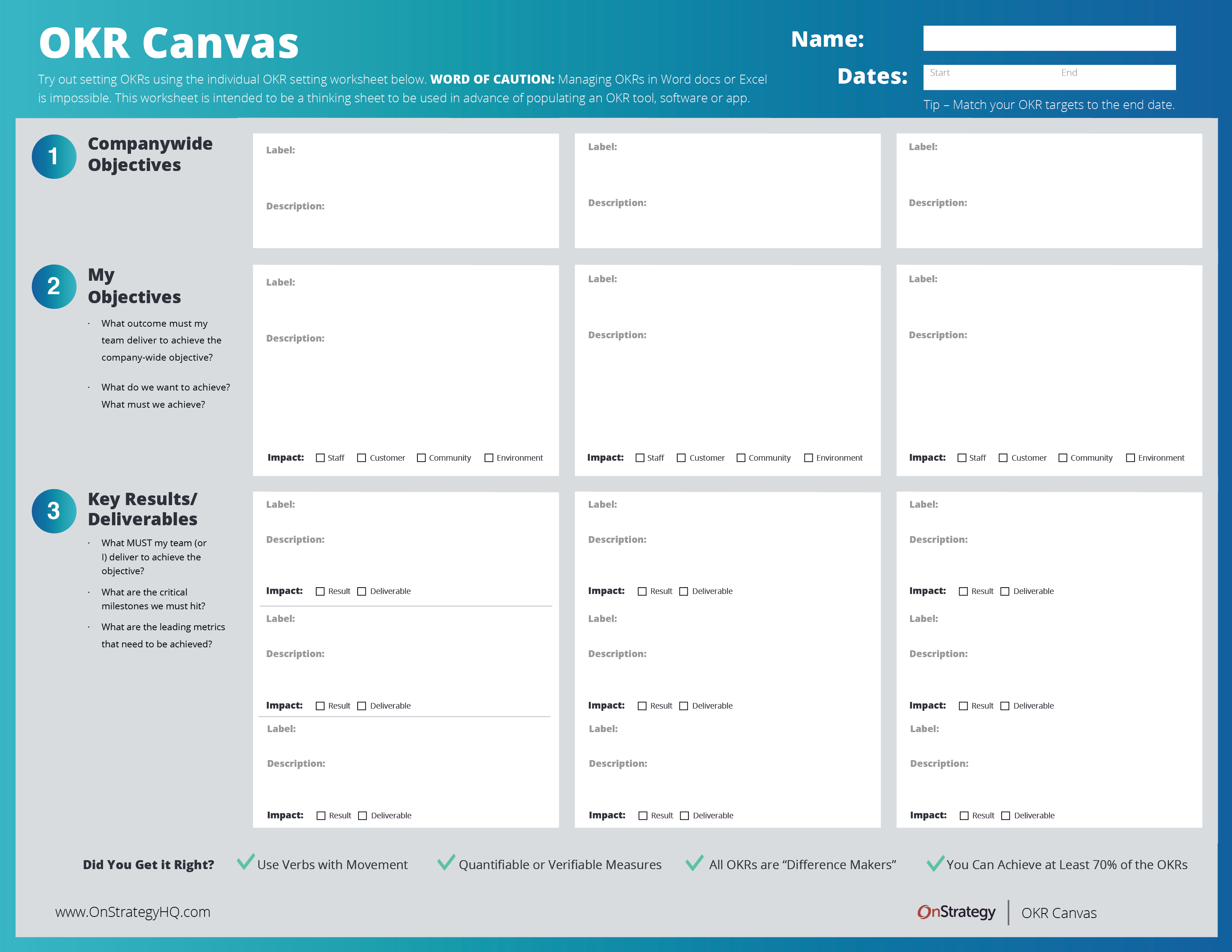In this 6-minute video, learn the anatomy of an OKR and how to write your own OKRs (Objectives and Key Results).

Video Transcription
How to Write ORKs
Today, we’re going to learn about how to write great OKRs by breaking it down into simple steps. If you do not know what an OKR is, watch our introduction video here.
What is an OKR?
OKRs stand for objectives and key results and it is a methodology for setting and cascading goals throughout an organization.
When we think about OKRs, we’re talking about O and the KRs as if it’s a single unit that are set at a company-wide, team level, and individual level. The great thing about OKRs is how specific they are and how each can be unique.
The O’s, or your objectives, are really about the what – what is the outcome you are going to deliver to the organization? It needs to be ambitious, a little bit uncomfortable, and stay true to the idea of an, “outcome.”
The KRs are the how you’ll achieve the outcome. Normally, there are a handful of “hows” you need to think about to deliver the outcome of the O. So, you need to be thinking about the two, three, or four key results you must deliver to achieve the outcome of the objective.
Setting Up & Writing Your OKRs
Oftentimes, OKRs are reset quarterly. This means you’ll set a brand new key result or set a new target on a quarterly basis.
Below is an example of one company-wide OKR:
O: Diversify by expanding into three new markets.
This is great because it’s specific, ambitious, big, and clear.
For a KR example, here are three examples you might need to execute to achieve that particular outcome:
- KR1: Grow revenue from new markets from 0-10% by the end of the planning period.
- KR2: Customize the highest margin offering to be market- and language-relevant.
- KR3: Sign contracts with one in-market partner per market.
Growing revenue from the new markets is a really specific key result, and you certainly won’t go from 0 to 10% in a 90-day period. It’s not realistic. But you might set a target that is specific to the upcoming quarter, maybe 1%.
Differently, you might have something like customizing an offering, which is more of a project. It might be something that you could get done in a quarter, in which case, that KR would go away and then you would replace it with something else.
This is an example of a specific Key Result that aligns to the other O and other KRs that is both specific and measurable. It clearly articulates a result that must be achieved to reach the desired outcome.
When we talk about OKRs, we’re talking about this as a unit of an Outcome and then a handful of Key Results you must deliver to achieve the outcome. A good guideline is two or three per person. Sometimes people say five, but we think that’s too many.
Pro-Tips for Writing OKRs
OKRs Need to Have Clear Ownership
OKRs need to owned, preferably by someone who owns the whole stack. This might be owned by the CEO, this might be owned by the VP of marketing, etc.
Use Verbs with Action
Using a verb is so important. In the example above, you can see examples like diversify, grow, customize, lower, hire, launch. Use something with concrete action and movement.
If you use a verb with action, you’ll get there.
Make them Measurable
The most important thing about OKRs is measurability, either verifiable or quantifiable.
Quantifiable is a specific numeric outcome, i.e., growing revenue from X to Y. You can measure this based on the revenue.
Verifiable is our example of customizing one new offering. You can verify that it’s done.
Often, people say, all OKRs need to have numbers in them. We think that can be hard. Sometimes it’s a great thing to shoot for, but sometimes it can just be verifiable.
More Than Just Company Value – Add Impact
OKRs can be more than just about company value. It can also be about something else – something bigger, be it a bigger impact or having profit plus purpose.
Think about adding OKRs to have a broader impact than just growing your business. Think about how you might impact staff in a positive way – maybe it’s engagement, satisfaction, or an innovative project.
You might also consider adding a customer impact OKR. We don’t mean customer satisfaction, but rather something that positively impacts the customer. An impact measure for customers might something like, “lowering customer’s total IT expense.” That’s a great example of an impact measure that certainly is good for you, but is really impactful to your customer.
Another example, of course, of impact measures or use to these would be a community impacting measure (your standard corporate social responsibility).
And then, of course, an environmental impact measure maybe around footprint, energy use, travel, that type of thing. It’s possible to do this all the time, but think about making sure, you have something that’s beyond just company value. It’s company value plus.
Download the Free Guide for Setting OKRs that Work!
Get the free guide and canvas to learn how you can leverage the OKR (objective and key result) model for goal setting and accountability that was popularized by Google.













